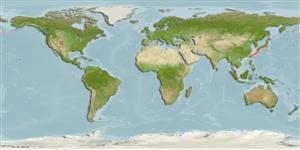Teleostei (teleosts) >
Pleuronectiformes (Flatfishes) >
Cynoglossidae (Tonguefishes) > Symphurinae
Etymology: Symphurus: Greek, syn, symphysis = grown together + Greek, oura = tail (Ref. 45335).
More on author: Hubbs.
Environment: milieu / climate zone / depth range / distribution range
Ecology
Marine; bathydemersal; depth range 390 - 815 m (Ref. 35979). Deep-water
Distribution
Countries | FAO areas | Ecosystems | Occurrences | Point map | Introductions | Faunafri
Northwest Pacific: probably endemic to deep waters off the southern Japanese Archipelago.
Size / Weight / Age
Maturity: Lm ? range ? - ? cm
Max length : 12.2 cm SL male/unsexed; (Ref. 35979)
Dorsal spines (total): 0; Dorsal soft rays (total): 111 - 113; Anal spines: 0; Anal soft rays: 95; Vertebrae: 59. Distinguished from congeners by having 1-2-3 interdigitation pattern (ID) of proximal dorsal pterygiophores and interneural spines; 10 abdominal vertebrae; 14 caudal-fin rays; 105-106 scales in longitudinal series; a pigmented blind side nearly as dark as the ocular surface; and black peritoneum (Ref. 35979).
Collected from sand or sand-mud bottom (Ref. 35979). Unpublished maximum depth given at 1040 m (in Ref. 127475).
Life cycle and mating behavior
Maturities | Reproduction | Spawnings | Egg(s) | Fecundities | Larvae
Munroe, T.A. and K. Amaoka, 1998. Symphurus hondoensis Hubbs, 1915, a valid species of Western Pacific tonguefish (Pleuronectiformes: Cynoglossidae). Ichthyol. Res. 45(4):385-391. (Ref. 35979)
IUCN Red List Status (Ref. 130435)
Threat to humans
Harmless
Human uses
Tools
Special reports
Download XML
Internet sources
Estimates based on models
Preferred temperature (Ref.
123201): 7.1 - 11.3, mean 8.5 °C (based on 22 cells).
Phylogenetic diversity index (Ref.
82804): PD
50 = 0.5000 [Uniqueness, from 0.5 = low to 2.0 = high].
Bayesian length-weight: a=0.01445 (0.00647 - 0.03228), b=3.05 (2.85 - 3.25), in cm total length, based on LWR estimates for this (Sub)family-body shape (Ref.
93245).
Trophic level (Ref.
69278): 3.3 ±0.4 se; based on size and trophs of closest relatives
Resilience (Ref.
120179): Medium, minimum population doubling time 1.4 - 4.4 years (Assuming tmax>3).
Fishing Vulnerability (Ref.
59153): Low vulnerability (10 of 100).
